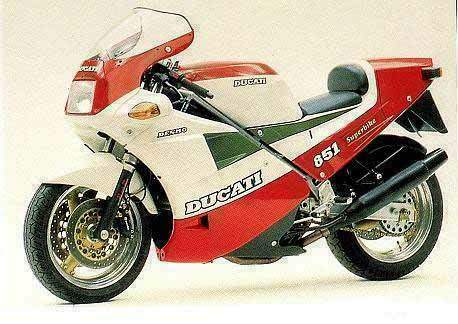 Read more about this motorcycle. Specification, detail, pictures and video. Please comments and give rating, tell others about it. Feel free to look around, we open 24 hours a day.
Read more about this motorcycle. Specification, detail, pictures and video. Please comments and give rating, tell others about it. Feel free to look around, we open 24 hours a day.
Make ModelDucati 851 Superbike Kit
Year: 1988
Engine: Liquid cooled, four stroke, 90°“L”twin cylinder, DOHC, desmodromic 4 valve per cylinder.
Capacity: 851
Bore x Stroke: 92 x 64 mm
Compression Ratio: 10.6:1
Induction: Weber electronic fuel injection. 2 50mm throttle bodies
Ignition / Starting: Inductive magnetically triggered / electric
Max Power: 119 hp 89 KW @ 10500 rpm
Max Torque: 7.26 kg-m @ 7250 rpm
Transmission / Drive: 6 Speed / chain
Front Suspension: Marzocchi Upside-down fork with rebound compression damping adjust.
Rear Suspension: Marzocchi mono shock with preload and damping adjust.
Front Brakes: 2x 280mm disc 4 piston calipers
Rear Brakes: Single 260mm disc 2 piston caliper
Front Tire: : 120/70 ZR17
Rear Tire: : 180/55 ZR17
Dry-Weight: 165 kg
Fuel Capacity: 20 Litres
Ian Falloon from Motorcycle Trader magazine looks at the bike which started Ducati down the path to dominance in world superbike racing…
Ducati stunned the motorcycle world 21 Year: s ago by unveiling a new liquid-cooled, four-valve, fuel-injected twin at the Bol d’Or 24-hour endurance race. Displacing 748cc to comply with FIM regulations the 748 set a new standard for ugliness, and only lasted 13 hours. Despite this inauspicious race debut the Desmoquattro (Desmodromic cams with four valves per cylinder) project was up and running.
Ducati’s great Engine: er Fabio Taglioni had favoured building a V-four but when the four-valve V-twin Engine: exceeded 100 horsepower on the factory dyno in 748cc form its future was assured. The Desmoquattro soon grew to 851cc then 888cc before evolving into the 916 and 996 versions and eventually the Testastretta. Over its twenty-one Year: history this has been one of the most successful motorcycle designs ever, both on and off the race track.
As Ducati was a manufacturer producing less than 50,000 motorcycles a Year: the homologation requirements for the new World Superbike series required 200 units of the 851 to be built for 1988. This homologation machine was the 851 Superbike Kit, a confused mixture of racer and street bike. It was certainly the only racing bike that came from the factory with Michelin racing slick tires, electric start, headlight and taillight. Alongside the 851 Superbike Kit was the first street series of 851, the 851 Strada. These were limited production machines, with only 304 manufactured in April 1988.
Compared to any other twin on the market in 1988 the 851 Strada was groundbreaking. It was the only motorcycle with an open-loop fully-mapped electronic fuel injection system. The Weber Marelli IAW system was originally developed for the Ferrari F40 sports car and Formula One and incorporated a computer with an EPROM (electronically programmable read only memory). This contained a map of fuel and ignition requirements derived from dyno tests. Although the first 851 Strada only produced a modest 102 horsepower at 9,000 rpm this was considerably more than any other twin available in 1988.
When it came to the Frame: and suspension Ducati continued its tradition of evolution of existing designs. The Frame: was based on the 750 F1, but with a rising-rate rear end and the 16-inch Marvic/Akront composite wheels (aluminium rims with magnesium spokes) from the limited edition 750Montjuich. As it was a limited production item many of the components were individually crafted, including the 20-litre aluminium fuel tank and rear-suspension rocker linkage. Unfortunately, while the quality of execution was high the 1988 851 Strada was a flawed motorcycle. The performance was disappointing considering the hype, and the claimed dry Weight: of 185 kilograms was optimistic. Yet while the 851 Strada didn’t live up to every expectation it is important because this is where the Desmoquattro story began. At the first World Superbike race at Donington on April 3, 1988 Marco Lucchinelli rode the factory 851 to overall victory. It was the beginning of nearly twenty Year: s of desmo domination that shows no sign of abating.
FIVE BORDIFUL THINGS ABOUT THE 851
1. Ing. Massimo Bordi joined Ducati in 1978 after completing an Engine: ering thesis on an air-cooled, four-valve, desmodromic cylinder head. He initially worked on diesel Engine: s before assisting Fabio Taglioni with the bevel-drive Mille.
2. Bordi was also a particular admirer of Cosworth, an English company created by Mike Costin and Keith Duckworth, that produced some of the most successful ever Formula One car racing Engine: s.
3. From September 1985 until January 1986 Bordi worked with Cosworth on the four-valve cylinder head design. Cosworth offered to develop and produce a prototype non-desmodromic Engine: for 1.5 billion Lire. As it had unsuccessfully experimented with desmodromics on its DFV/DFY V-eight it wouldn’t commit to a desmo.
4. Bordi considered four-valve heads with conventional valve springs, five valves (as with the Yamaha), or six valves (Maserati) but finally decided on a four-valve desmo. Bordi wanted to call it the 850 but Gianluigi Mengoli persuaded Bordi to call it the 851, to avoid any association with the doomed Fiat 850 automobile.
5. In early 1986 Mengoli began initial Engine: drawings, completing these in April. The first design had straight ports inclined at 30 degrees, with very close rockers and side-mounted spark plugs but was soon revised to allow space for a central spark plug. Following Bordi’s departure from Ducati in 2001 Mengoli has been technical director.
Source Bikepoint